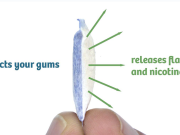The study titled, “Dripping and Vape Tricks: Alternative E-Cigarette Use Behaviors Among Adolescents,” found that engaging in dripping (i.e., applying e-liquid directly on the atomizer) and vape tricks (i.e., creating shapes from exhaled aerosol) tends to be passed on socially via peer groups.
Analyzing data from 2945 high school students, the researchers found that among ever e-cigarette users, 20.5% had ever dripped and 54.9% had ever conducted vape tricks. Other data that emerged from this study were that the most frequently used flavours were fruit, candy, and mint, and that the nicotine concentration commonly used for dripping was 3 mg, while for vape tricks it was 0 mg.
The study also indicated an association between dripping and vape tricks, and an earlier age of e-cigarette use onset, past-month-use of e-cigarettes, and lifetime use of other tobacco products. “Engaging in dripping and vape tricks was associated with risky tobacco use behaviors (e.g., earlier age of onset, other tobacco use), and involved exposure to nicotine and flavors. Reducing appeal of dripping and vape tricks and preventing product characteristics that facilitate these behaviors may reduce harm to adolescents,” read the study Abstract.
The “Cool” factor not flavours is what attracts teens to vaping
Meanwhile, another recent study from the University of Michigan, has shown that as was the case with cigarette smoking in the past, the main motivator behind teen vaping is the “cool” factor derived from using e-cigarettes.
“The message about the dangers of smoking tobacco was just getting through, and then vaping came along and we may now have a whole new generation addicted to nicotine,” said study author Tammy Chang. Published in in JAMA Pediatrics, the MyVoice study responses were gathered via a text-message survey from teens and young adults between the ages of 14 and 24.
The researchers found that nearly two-thirds of the study participants teens said that the social aspects of vaping is what drives them to use Juul and other electronic devices. Less than 5% of the participants mentioned the availability of fruity flavours drives as a motivator.












